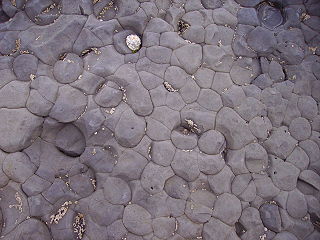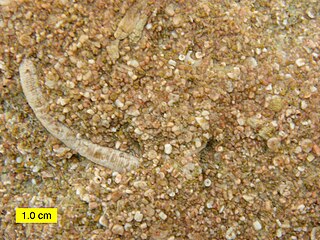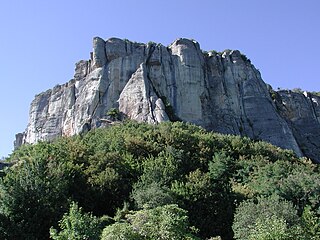
Limestone is a type of carbonate sedimentary rock which is the main source of the material lime. It is composed mostly of the minerals calcite and aragonite, which are different crystal forms of CaCO3. Limestone forms when these minerals precipitate out of water containing dissolved calcium. This can take place through both biological and nonbiological processes, though biological processes, such as the accumulation of corals and shells in the sea, have likely been more important for the last 540 million years. Limestone often contains fossils which provide scientists with information on ancient environments and on the evolution of life.

Sedimentary rocks are types of rock that are formed by the accumulation or deposition of mineral or organic particles at Earth's surface, followed by cementation. Sedimentation is the collective name for processes that cause these particles to settle in place. The particles that form a sedimentary rock are called sediment, and may be composed of geological detritus (minerals) or biological detritus. The geological detritus originated from weathering and erosion of existing rocks, or from the solidification of molten lava blobs erupted by volcanoes. The geological detritus is transported to the place of deposition by water, wind, ice or mass movement, which are called agents of denudation. Biological detritus was formed by bodies and parts of dead aquatic organisms, as well as their fecal mass, suspended in water and slowly piling up on the floor of water bodies. Sedimentation may also occur as dissolved minerals precipitate from water solution.

Metamorphism is the transformation of existing rock to rock with a different mineral composition or texture. Metamorphism takes place at temperatures in excess of 150 °C (300 °F), and often also at elevated pressure or in the presence of chemically active fluids, but the rock remains mostly solid during the transformation. Metamorphism is distinct from weathering or diagenesis, which are changes that take place at or just beneath Earth's surface.

The lithology of a rock unit is a description of its physical characteristics visible at outcrop, in hand or core samples, or with low magnification microscopy. Physical characteristics include colour, texture, grain size, and composition. Lithology may refer to either a detailed description of these characteristics, or a summary of the gross physical character of a rock. Examples of lithologies in the second sense include sandstone, slate, basalt, or limestone.

Mudstone, a type of mudrock, is a fine-grained sedimentary rock whose original constituents were clays or muds. Mudstone is distinguished from shale by its lack of fissility.

Carbonate rocks are a class of sedimentary rocks composed primarily of carbonate minerals. The two major types are limestone, which is composed of calcite or aragonite (different crystal forms of CaCO3), and dolomite rock (also known as dolostone), which is composed of mineral dolomite (CaMg(CO3)2). They are usually classified based on texture and grain size. Importantly, carbonate rocks can exist as metamorphic and igneous rocks, too. When recrystallized carbonate rocks are metamorphosed, marble is created. Rare igneous carbonate rocks even exist as intrusive carbonatites and, even rarer, there exists volcanic carbonate lava.
The Folk classification, in geology, is a technical descriptive classification of sedimentary rocks devised by Robert L. Folk, an influential sedimentary petrologist and Professor Emeritus at the University of Texas.

The Dunham classification system for carbonate sedimentary rocks was originally devised by Robert J. Dunham in 1962, and subsequently modified by Embry and Klovan in 1971 to include coarse-grained limestones and sediments that had been organically bound at the time of deposition. The modified Dunham Classification has subsequently become the most widely employed system for the classification of carbonate sedimentary rocks with 89% of workers currently adopting this system over the alternative Folk classification scheme

Calcarenite is a type of limestone that is composed predominantly, more than 50 percent, of detrital (transported) sand-size, carbonate grains. The grains consist of sand-size grains of either corals, shells, ooids, intraclasts, pellets, fragments of older limestones and dolomites, other carbonate grains, or some combination of these. Calcarenite is the carbonate equivalent of a sandstone. The term calcarenite was originally proposed in 1903 by Grabau as a part of his calcilutite, calcarenite and calcirudite carbonate classification system based upon the size of the detrital grains composing a limestone. Calcarenites can accumulate in a wide variety of marine and non-marine environments. They can consist of grains of carbonate that have accumulated either as coastal sand dunes (eolianites), beaches, offshore bars and shoals, turbidites, or other depositional settings.

Under the Dunham classification system of limestones, a wackestone is defined as a mud-supported carbonate rock that contains greater than 10% grains. Most recently, this definition has been clarified as a carbonate-dominated rock in which the carbonate mud component supports a fabric comprising 10% or more very fine-sand grade or larger grains but where less than 10% of the rock is formed of grains larger than sand grade .

Under the Dunham classification system of limestones, a grainstone is defined as a grain-supported carbonate rock that contains less than 1% mud-grade material. This definition has recently been clarified as a carbonate-dominated rock that does not contain any carbonate mud and where less than 10% of the components are larger than 2 mm. The spaces between grains may be empty (pores) or filled by cement.

Under the Dunham classification system of limestones, a packstone is defined as a grain-supported carbonate rock that contains 1% or more mud-grade fraction. This definition has been clarified by Lokier and Al Junaibi (2016) as a carbonate-dominated lithology containing carbonate mud in a fabric supported by a sand grade grain-size fraction and where less than 10% of the volume consists of grains >2 mm.

Igneous rock, or magmatic rock, is one of the three main rock types, the others being sedimentary and metamorphic. Igneous rocks are formed through the cooling and solidification of magma or lava.

Floatstone is a type of carbonate rock.
Calcilutite is a type of limestone that is composed of predominantly, more than 50 percent, of either clay-size or both silt-size and clay-size detrital (transported) carbonate grains. These grains consist either of fossil fragments, ooids, intraclasts, pellets, other grains, or some combination of them. The term calcilutite was originally proposed in 1903 by Grabau as a part of his calcilutite, calcarenite and calcirudite classification system based upon the size of the detrital grains composing a limestone. In the original classification of limestone according to the dominant grain-size, calcisiltites were not named and are classified as calcilutite. In this classification, which the majority of geologists follow, a calcilutite consists of both silt- and clay-size, less than 0.062 mm in diameter, grains. It is the carbonate equivalent of a mudstone. Calcilutites can accumulate in a wide variety of marine and lacustrine environments.

Bafflestone is a type of carbonate rock.
A boundstone is a special type of carbonate rock in the Dunham classification
Bindstone is a special type of carbonate rock in the Dunham classification. The term did not appear in the original Dunham classification from 1962 and was introduced by Embry and Klovan 1971 in the modified Dunham classification.
A framestone is a special type of carbonate rock in the Dunham classification.














